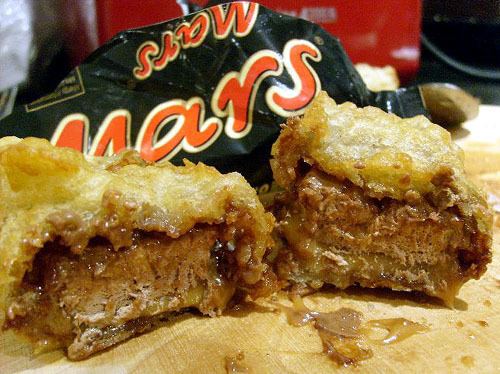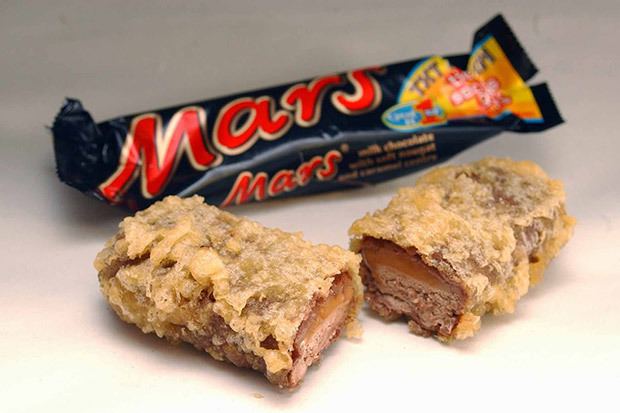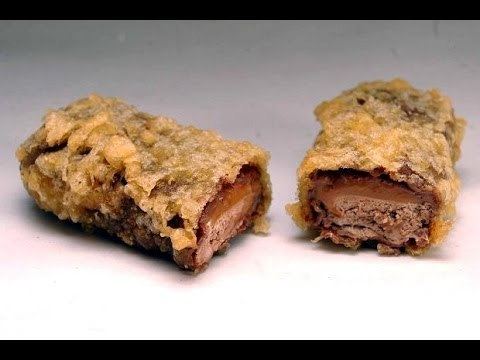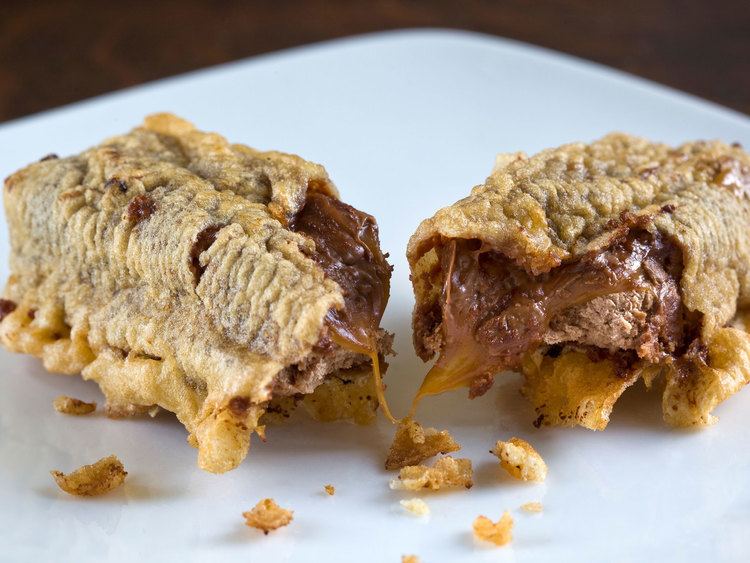Main ingredients Mars, Batter | ||
 | ||
Similar Deep‑fried pizza, Haggis, Deep fried Oreo, Deep‑fried butter, Irn‑Bru | ||
Eating a deep fried mars bar in edinburgh scotland
A deep-fried Mars bar is an ordinary Mars bar normally fried in a type of batter commonly used for deep-frying fish, sausages, and other battered products. The chocolate bar is typically chilled before battering to prevent it from melting into the frying fat, though a cold Mars bar can fracture when heated.
Contents
- Eating a deep fried mars bar in edinburgh scotland
- History
- Popularity
- Culinary influence
- Media totem for ill health
- References

The dish originated at chip shops in Scotland as a novelty item, but was never mainstream. Since various mass media have reported on the practice since the mid-1990s, in part as a commentary on urban Scotland's notoriously unhealthy diet, the popularity of the dish has spread. The product has not received support from Mars, Inc who said "deep-frying one of our products would go against our commitment to promoting healthy, active lifestyles."

History

The dish is said to have been created in 1995 in the Haven Chip Bar (now the Carron) in Stonehaven, near Aberdeen on Scotland's northeast coast.

The first recorded mention of the food was in the Aberdeen Evening Express, following a tip off phone call to their journalist Alastair Dalton that a chip shop in Stonehaven had been deep frying Mars Bars for local children. The article included a quote from Mars spokesperson who said this was the first time they had heard of this being done with their product. The following day the story was picked up and run in the Daily Record, August 24, 1995, in an article titled "Mars supper, please". Scottish broadsheets The Herald and Scotsman ran the story the following day and the UK broadsheets the day after, each adding their own cultural slant. On the fifth day Keith Chegwin performed taste tests on The Big Breakfast TV program and the story was covered by the BBC World Service.

In July 2015, Aberdeenshire Council instructed the proprietors of the Carron Fish Bar to remove a banner advertising the shop as the origin of the product. The council wish to "improve the look of Stonehaven". However, the proprietors have refused to remove the banner.
Popularity
After the food was mentioned in 2004 by Jay Leno on NBC's Tonight Show in the United States, The Lancet commissioned the University of Dundee in June 2004 to validate the association between Scotland and the deep-fried Mars bar.
After undertaking a telephone questionnaire survey of 627 fish and chip shops in Scotland, the results published in December 2004 attempted to discover how available the deep-fried Mars bar was, and if people were actually buying them. The survey found:
In 2012, the Carron Fish Bar in Stonehaven (formerly called the Haven) which began the craze, estimated sales of 100–150 deep-fried Mars bars per week, but that 70% were sold to visitors who have heard of its reputation.
Culinary influence
In 2000, Scottish chef Ross Kendall included the bars on the menu of Le Chipper restaurant in Paris.
The deep-fried Mars bar has also given rise to the frying of other confections, for example, Reiver's Fish Bar in Duns annually advertises an 'Easter Special' of deep-fried Creme Egg, although this is available all year. Deep-fried Snickers have also been reported, particularly in the US where that brand is more popular. In her book and television series Nigella Bites, Nigella Lawson includes a recipe for a deep-fried Bounty bar. Deep-fried Moro bars are also sold in New Zealand, where the brand is popular.
Media totem for ill health
Since it was first reported in the media in August 1995, when the Daily Record ran an article entitled "Scotland's craziest takeaway", the deep-fried Mars bar has become a media-totem for ill health, obesity and high-fat diets. The original article was quickly followed up by other UK publications, with the food portrayed to speak eloquently about Scotland's and the wider UK's poor diet, and resultant levels of obesity.
In 2012, the Haven sought an application for secured status under the EU's Protected Food Name Scheme. But Mars wrote to the fish bar asking it to make plain that deep-frying of the bars was "not authorised or endorsed" by Mars, and an agreed disclaimer statement was put up in both the shop and in its menu.
The deep fried Mars bar was one outcome factor amongst many theories behind the "Glasgow effect", whereby the city has a notedly higher mortality rate than many cities of the same size and scale. One theory suggested that its residents have a naturally pessimistic disposition, and that eating unhealthy food was an example of their tendency to put "a lower price on the future". In a 2012 interview, Glasgow restaurateur John Quigley felt that Scotland had been trying to "shake off" its unhealthy image for 20 years, since the media coverage of the deep-fried Mars bar.
